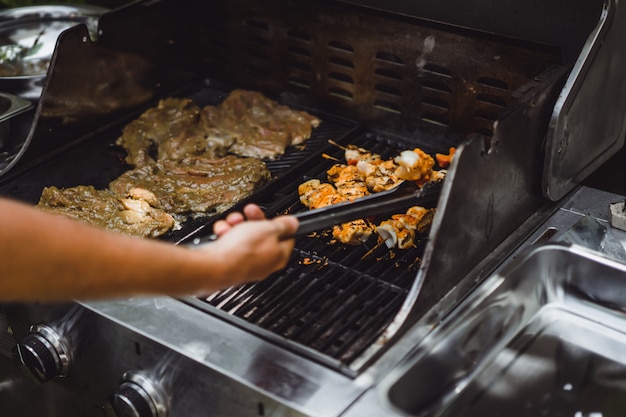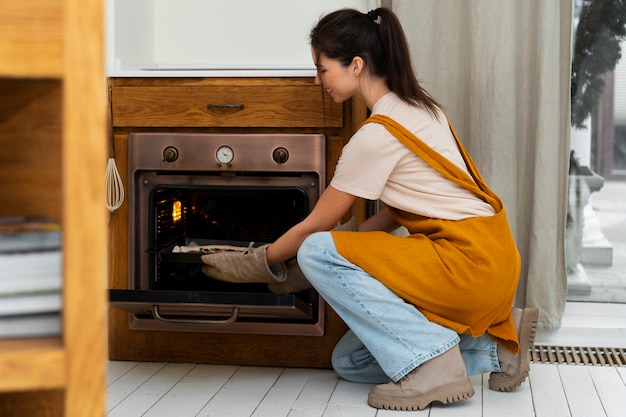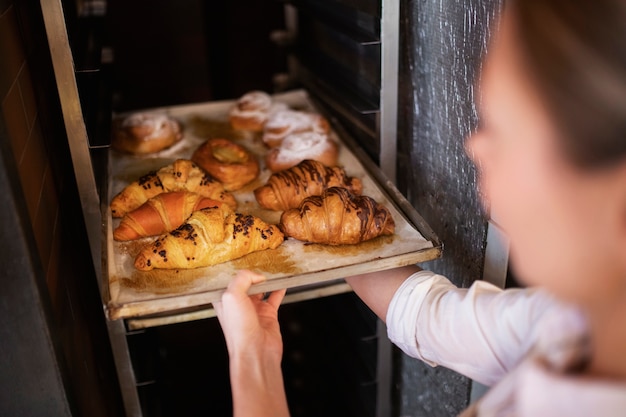(Part 1) choosing the right cut: The Foundation of a Great Roast

The first step in any roast beef endeavor is selecting the right cut. Think of it as choosing the right foundation for a magnificent building. There are a few classic choices, each with its own distinct personality, offering a different flavor profile and texture. Let's break it down:
The Prime Cuts: For Those Seeking the Ultimate Indulgence
- rib roast: This is my absolute favorite, boasting a rich, buttery flavor and a tender texture that simply melts in your mouth. It's the Rolls-Royce of roast beef cuts, a bit more expensive, but oh so worth it. Always go for a standing rib roast for the most impressive presentation and the best flavor. It's the kind of roast that makes your guests say, "Wow!"
- sirloin roast: A solid all-rounder, sirloin offers a leaner, slightly firmer texture compared to its rib-roast cousin, but still packs a punch in the flavor department. It's a great choice for those seeking a more substantial, hearty roast.
- Tenderloin (filet mignon): The epitome of tenderness, tenderloin is a perfect choice for a special occasion. It's a delicate creature, however, so it needs to be handled with care to avoid overcooking. Remember, the goal is that melt-in-your-mouth experience.
The More budget-friendly Options: Still Delicious, Just a Little More Down-to-Earth
- chuck roast: This tough-as-nails cut is a champion of braising but can also shine as a roast if you embrace the slow and low approach. Its deep, robust flavor is a testament to its hard-working nature. Think of it as the reliable workhorse of the roast beef world.
- top round roast: Another lean contender, top round is best cooked medium-rare to prevent dryness. It's a great option for large gatherings, often coming in sizable portions. It's a bit like the reliable family car, always ready for the journey.
(Part 2) Preparing the Roast Beef: The Art of Getting Ready

Now that you've chosen your perfect cut, it's time to get your roast beef ready for its starring role. This involves a few key steps that will transform your basic roast into a culinary masterpiece.
Seasoning: The Flavor Amplifier
Don't be shy about experimenting with your seasoning! The classic combo of salt, pepper, and garlic is a winning formula, but feel free to add your own personal touch. I often throw in a sprinkle of dried herbs like rosemary or thyme for an extra layer of flavor. For those looking to spice things up, consider these options:
- Herbs and Spices: A blend of dried herbs like thyme, rosemary, oregano, and marjoram, along with a touch of garlic powder and onion powder, creates a fragrant and aromatic crust.
- Mustard: A thin layer of Dijon mustard applied to the roast before seasoning helps to caramelize and add a tangy dimension to the flavor. It's a simple yet effective way to elevate the roast.
- Garlic Butter: A simple mix of softened butter and minced garlic, rubbed all over the roast, brings a rich, garlicky aroma and a melt-in-your-mouth texture. It's a true classic for a reason.
roasting pan and Rack: The Perfect Duo for Even Cooking
Using a roasting pan and rack is essential for even cooking. The rack lifts the roast above the pan, allowing hot air to circulate freely around it. This ensures that the meat cooks evenly without getting steamy and mushy. Think of the rack as a platform that allows the roast to breathe.
The Fat: Adding Moisture and Flavor
Depending on your chosen cut, you may need to add a bit of fat to the pan to prevent the roast from becoming dry. If your cut is on the leaner side, I recommend using a combination of olive oil and butter for a flavorful and moist cooking environment. This will help the roast retain its juicy goodness.
(Part 3) Cooking Time and Temperature: The Science of Roast Beef

Now we arrive at the pivotal moment – figuring out the cooking time and temperature. This is where some might start to feel a bit of pressure, but fear not, this is where my years of experience come in handy.
The Rule of Thumb: A Starting Point for Your Roast Beef Journey
A good rule of thumb is to cook a roast beef at 350 degrees fahrenheit (175 degrees Celsius) for 15 to 20 minutes per pound. This is a general guideline, but remember, every roast is unique. The actual cooking time can be influenced by factors like the cut of meat and your desired level of doneness.
Doneness Chart: A Guide to Your Roast Beef Preferences
To ensure a roast beef that satisfies your cravings, use this handy chart to determine the cooking time based on your preferred doneness:
| Doneness | internal temperature (Fahrenheit) | Approximate Cooking Time (per pound) |
|---|---|---|
| Rare | 125-130°F | 15 minutes |
| Medium-Rare | 130-135°F | 17 minutes |
| Medium | 140-145°F | 19 minutes |
| Medium-Well | 150-155°F | 21 minutes |
| Well-Done | 160°F and above | 23 minutes |
Keep in mind that these are just estimates. Always use a meat thermometer to ensure your roast is cooked to your liking. I always recommend checking the temperature a few minutes before the estimated time is up. It's better to be safe than sorry, especially when it comes to meat.
(Part 4) Resting the Roast Beef: A Key to Tenderness and Juiciness
Once your roast beef is cooked to perfection, don't rush to carve it. Resist the temptation! Let it rest for at least 15 minutes before you start slicing. Why? Because resting allows the juices to redistribute throughout the meat. This results in a more tender, juicy roast, a truly satisfying culinary experience.
(Part 5) Carving the Roast Beef: The Art of Unveiling the Masterpiece
After the resting period, it's time to carve your culinary masterpiece! Use a sharp carving knife for clean, precise cuts. This is where your artistry comes into play.
Carving Techniques: Slicing to Perfection
- Slice against the grain: This technique helps to break down the muscle fibers and make the meat more tender. Think of it as unraveling the intricate threads of the roast.
- Cut thin slices: Thin slices are easier to chew and allow the juices to permeate the meat, resulting in a more flavorful experience. Picture yourself savoring each bite, the flavors mingling on your palate.
(Part 6) Serving Suggestions: A Symphony of Flavors
With your perfectly cooked and carved roast beef ready to go, it's time to create a culinary symphony of flavors! Roast beef is a versatile dish, playing well with a wide range of accompaniments.
Accompaniments: The Perfect Harmony
Here are a few suggestions to create a truly delightful roast beef experience:
- Yorkshire Pudding: A classic British accompaniment, Yorkshire pudding is light, fluffy, and perfect for soaking up the gravy. It's a culinary hug, warm and comforting.
- Roasted Vegetables: Roasted root vegetables like carrots, potatoes, and parsnips bring a touch of sweetness and earthy flavor to the meal. I like to toss them with herbs and a little olive oil before roasting, letting their natural sweetness shine. It's a taste of autumn on your plate.
- mashed potatoes: A creamy and comforting side that complements the savory flavor of roast beef. Mashed potatoes are a warm embrace, a reminder of home-cooked meals and happy memories.
- green beans: Steamed or sautéed green beans add a touch of freshness and color to the plate. They provide a vibrant counterpoint to the richness of the roast.
- Gravy: No roast beef meal is complete without gravy! You can make a simple pan gravy from the drippings in the roasting pan or use a store-bought version. Gravy adds a rich, savory layer that elevates the overall experience.
(Part 7) Leftovers: Don't Waste Those Delicious Morsels
If you happen to have leftovers, don't despair! They're perfect for sandwiches, salads, or even a hearty soup. I love slicing the leftover roast beef thinly and adding it to a salad with a creamy dressing and some crunchy vegetables. It's a delightful way to enjoy the flavors of your roast beef in a lighter, more refreshing way.
(Part 8) Tips and Tricks: Mastering the Art of Roast Beef
Here are a few tips and tricks I've picked up over the years to help you create a truly remarkable roast beef, a dish that will impress your friends and family. These are the secrets to achieving roast beef perfection:
- Sear the roast: Before you place it in the oven, sear the roast on all sides in a hot pan. This adds a beautiful crust and locks in the juices, giving your roast a delicious depth of flavor. It's like giving your roast beef a golden kiss.
- Don’t overcrowd the pan: If you're roasting a large roast beef, you may need to use two roasting pans to ensure that the meat cooks evenly. This will prevent the roast from steaming and ensure that every inch is cooked to perfection.
- Use a meat thermometer: A meat thermometer is essential for ensuring your roast is cooked to perfection. Don't rely on guesswork; trust the thermometer! It's your culinary guide to achieving the perfect level of doneness.
- Baste the roast: To keep the roast moist, baste it with pan drippings or a mixture of butter and water every 30 minutes during cooking. This will help the roast retain its natural juices and create a beautiful, glistening finish.
- Let the roast rest: As mentioned earlier, resting the roast beef after cooking is crucial for tender and juicy results. Think of it as a chance for the roast to relax and rehydrate, becoming even more delicious.
(Part 9) FAQs: The Answers to Your Roast Beef Questions
I've covered a lot of ground in this guide, but you might still have a few lingering questions. Here are some frequently asked questions and my answers to help you become a roast beef pro:
1. What temperature should I cook a roast beef at?
The ideal temperature for roasting beef is 350 degrees Fahrenheit (175 degrees Celsius). This allows the meat to cook evenly and develop a delicious crust, creating a perfect balance of tenderness and flavor.
2. How long should I cook a roast beef?
The cooking time for roast beef will vary depending on the cut of meat, the size of the roast, and your desired level of doneness. As a general rule of thumb, cook a roast for 15 to 20 minutes per pound. Always use a meat thermometer to ensure you've achieved the perfect doneness.
3. How do I know when my roast beef is done?
The best way to determine if your roast beef is done is to use a meat thermometer. Insert the thermometer into the thickest part of the roast and check the temperature according to your preferred doneness. This will guarantee a perfectly cooked roast, every time.
4. How do I make the best gravy?
To make a delicious pan gravy, first, deglaze the roasting pan with a little wine or broth. Then, whisk in some flour and cook it for a few minutes. Slowly add in the pan drippings, whisking constantly until the gravy thickens. Adjust the seasoning to your liking, adding salt, pepper, and even a touch of herbs for extra depth of flavor. This is the foundation for a truly unforgettable gravy.
5. What are some alternative ways to cook roast beef?
Besides traditional roasting, you can also cook roast beef in a slow cooker or on a grill. slow cooking is a great way to make a tender, juicy roast, especially for tougher cuts. Grilling offers a smoky flavor, creating a unique and delicious twist on a classic dish.
I hope this comprehensive guide has given you the tools and confidence to conquer the art of roast beef. Remember, practice makes perfect. Don't be afraid to experiment with different cuts, seasonings, and cooking methods until you find what you love. Happy roasting!
Everyone is watching

Corn on the Cob: The Ultimate Guide to Perfectly Cooked Ears
Healthy MealsAh, corn on the cob. Just the name evokes images of sunny days, barbecues, and that sweet, juicy flavour that ...

Scallops: The Ultimate Guide to Perfect Cooking
Healthy MealsAh, scallops. Those delicate, sweet, and utterly delicious morsels of the sea. They hold a special place in my...

Spaghetti Squash: The Ultimate Guide to Cooking and Serving
Healthy MealsRemember that time you saw spaghetti squash at the supermarket, looking all bumpy and strange, and thought, "W...

Salmon Cooking Times: Perfect Guide for Every Recipe
Healthy MealsLet me tell you, cooking salmon is an art form. It's all about getting that perfect balance: juicy and tender,...

Ham Cooking Time: How Long to Bake, Smoke, or Boil a Delicious Ham
Healthy MealsAh, ham. It's a classic, isn't it? A real crowd-pleaser, especially around holidays. And when done right, it'...
